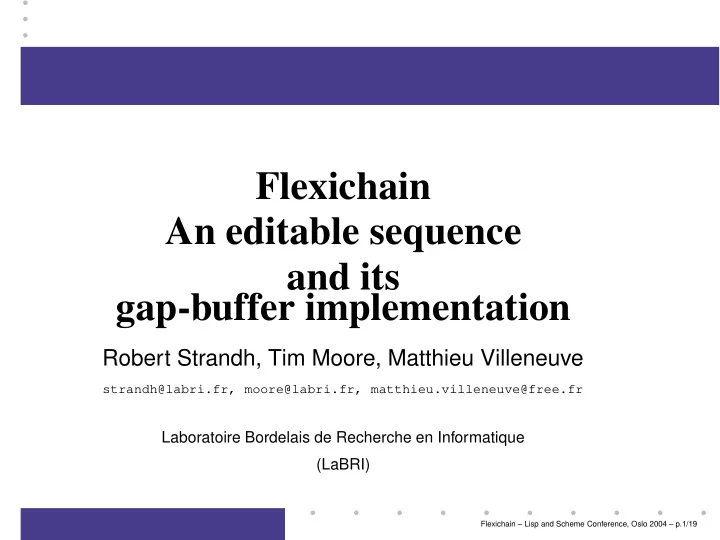

Flexichain An editable sequence and its gap-buffer implementation Robert Strandh, Tim Moore, Matthieu Villeneuve strandh@labri.fr, moore@labri.fr, matthieu.villeneuve@free.fr Laboratoire Bordelais de Recherche en Informatique (LaBRI) Flexichain – Lisp and Scheme Conference, Oslo 2004 – p.1/19
API Model An editable sequence of objects containing an arbitrary number of cursors. Cursors Arbitrary Objects Flexichain – Lisp and Scheme Conference, Oslo 2004 – p.2/19
Uses of API • Emacs-like text editors for the entire buffer • Emacs-like text editors for one line of a buffer • Emacs-like text editors for the sequence of lines • Gsharp (at 4 different levels) Flexichain – Lisp and Scheme Conference, Oslo 2004 – p.3/19
Possible representations • Doubly linked list • Gap buffer Flexichain – Lisp and Scheme Conference, Oslo 2004 – p.4/19
Doubly linked list Advantages: fast, easy to implement Inconveniences: no direct access, high memory overhead Flexichain – Lisp and Scheme Conference, Oslo 2004 – p.5/19
Gap buffer Advantages: direct access, low memory overhead Inconveniences: slow worst-case, hard to implement Flexichain – Lisp and Scheme Conference, Oslo 2004 – p.6/19
Previous work • Multics Emacs: a doubly-linked list of lines, each line a vector (special instructions) • GNU Emacs: entire buffer is a gap buffer • Hemlock: doubly-linked list of lines, the open line is a gap buffer • Goatee (McCLIM): doubly-linked list of lines, each line is a gap buffer • Gsharp: currently uses singly-linked lists Flexichain – Lisp and Scheme Conference, Oslo 2004 – p.7/19
Purpose of Flexichain In order of priorities: 1. Replace specialized, slow code in Gsharp 2. Replace line implementation in Goatee 3. Replace list of lines in Goatee 4. Perhaps use in portable Hemlock Flexichain – Lisp and Scheme Conference, Oslo 2004 – p.8/19
Two layers: Flexichain and cursorchain The Flexichain layer uses positions to access, insert, and delete elements. The Cursorchain layer uses cursors . The two are compatible. Flexichain – Lisp and Scheme Conference, Oslo 2004 – p.9/19
The Flexichain layer insert<* chain element position insert>* chain element position delete* chain position element* chain position (setf element*) position element chain Flexichain – Lisp and Scheme Conference, Oslo 2004 – p.10/19
Stack and queue operations push-start chain element push-end chain element pop-start chain pop-end chain rotate chain &optional (n 1) Flexichain – Lisp and Scheme Conference, Oslo 2004 – p.11/19
Implementation of Flexichain layer • Use a gap buffer • Consider the buffer as circular (avoids bad worst cases) • Expand and shrink factors • Moving the gap is messy Flexichain – Lisp and Scheme Conference, Oslo 2004 – p.12/19
Moving the gap Three situations exist: Move left or right according to the number of elements that need to be moved in each case. Flexichain – Lisp and Scheme Conference, Oslo 2004 – p.13/19
Moving the gap Flexichain – Lisp and Scheme Conference, Oslo 2004 – p.14/19
The Cursorchain layer at-beginning-p cursor at-end-p cursor move< cursor move> cursor insert< object cursor insert> object cursor delete< cursor &optional (n 1) delete> cursor &optional (n 1) element< cursor element> cursor Flexichain – Lisp and Scheme Conference, Oslo 2004 – p.15/19
The Cursorchain layer • cursorchain is a subclass of flexichain • cursors store physical position rather than logical positions in order to avoid updating all cursors at every operation • to avoid memory leaks, we use weak references to store cursors Flexichain – Lisp and Scheme Conference, Oslo 2004 – p.16/19
The Cursorchain layer • we use an internal protocol for resizing and for moving the gap • cursor update are done by :before and :after methods of internal protocol Flexichain – Lisp and Scheme Conference, Oslo 2004 – p.17/19
State of implementation Flexichain is finished. Cursorchain will be finished this summer (we all have daytime jobs). Flexichain – Lisp and Scheme Conference, Oslo 2004 – p.18/19
That’s all Thank You! Questions? Flexichain – Lisp and Scheme Conference, Oslo 2004 – p.19/19
Recommend
More recommend